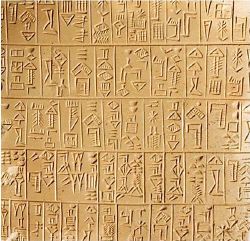Difference between revisions of "Template: Featured article 09 27" - New World Encyclopedia
From New World Encyclopedia
(Created page with "{{Main page article box| type=Featured| title=Cuneiform script| image_name=Sumerian 26th c Adab.jpg| image_desc=Sumerian inscription in monumental archaic style, c. twenty-sixth ...") |
|||
| Line 5: | Line 5: | ||
image_desc=Sumerian inscription in monumental archaic style, c. twenty-sixth century B.C.E.| | image_desc=Sumerian inscription in monumental archaic style, c. twenty-sixth century B.C.E.| | ||
text=The '''cuneiform script''' (kjuːˈniːəfɔrm) is the earliest known form of [[writing|written expression]]. As such, those writings that remain are [[communication]]s from peoples long gone from the earth. Created by the [[Sumer]]ians in approximately 3000 B.C.E., cuneiform writing began as a system of [[pictograph]]s. Over time, the pictorial representations became simplified and more abstract. Cuneiforms were inscribed on [[clay tablet]]s, on which [[symbol]]s were drawn with a blunt [[Phragmites|reed]] for a [[stylus]]. The impressions left by the stylus were wedge shaped, thus giving rise to the name cuneiform ("wedge shaped"). | text=The '''cuneiform script''' (kjuːˈniːəfɔrm) is the earliest known form of [[writing|written expression]]. As such, those writings that remain are [[communication]]s from peoples long gone from the earth. Created by the [[Sumer]]ians in approximately 3000 B.C.E., cuneiform writing began as a system of [[pictograph]]s. Over time, the pictorial representations became simplified and more abstract. Cuneiforms were inscribed on [[clay tablet]]s, on which [[symbol]]s were drawn with a blunt [[Phragmites|reed]] for a [[stylus]]. The impressions left by the stylus were wedge shaped, thus giving rise to the name cuneiform ("wedge shaped"). | ||
| − | + | }} | |
| − | |||
Revision as of 19:58, 26 August 2020
Featured Article: Cuneiform script
The cuneiform script (kjuːˈniːəfɔrm) is the earliest known form of written expression. As such, those writings that remain are communications from peoples long gone from the earth. Created by the Sumerians in approximately 3000 B.C.E., cuneiform writing began as a system of pictographs. Over time, the pictorial representations became simplified and more abstract. Cuneiforms were inscribed on clay tablets, on which symbols were drawn with a blunt reed for a stylus. The impressions left by the stylus were wedge shaped, thus giving rise to the name cuneiform ("wedge shaped").
